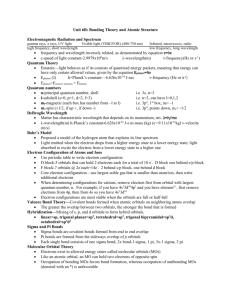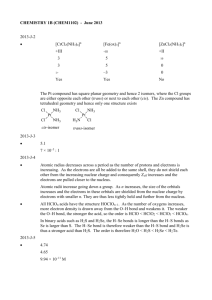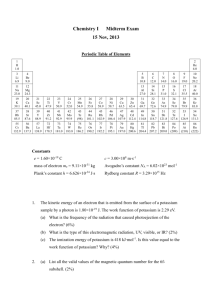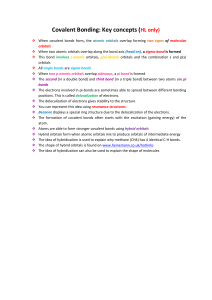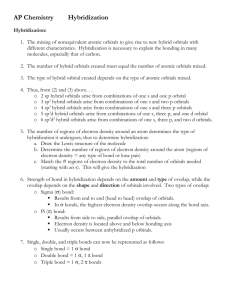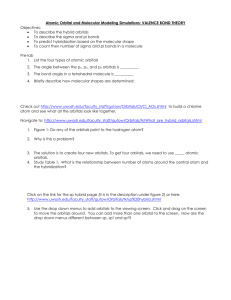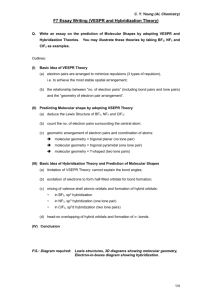- GlobalZona.com
advertisement
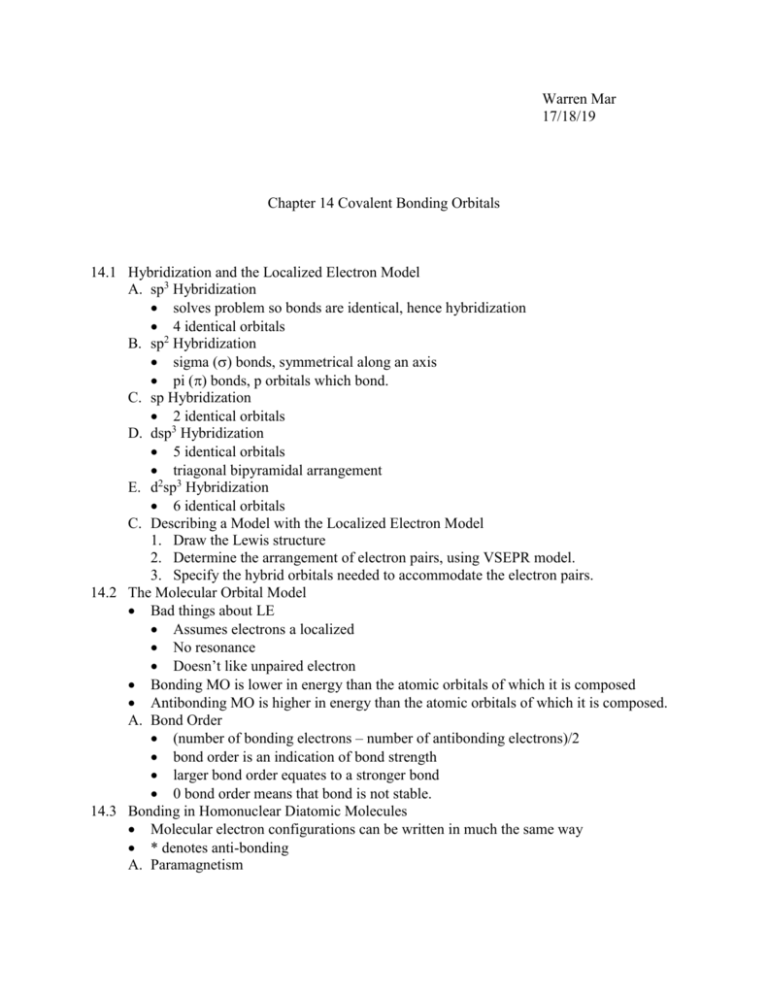
Warren Mar 17/18/19 Chapter 14 Covalent Bonding Orbitals 14.1 Hybridization and the Localized Electron Model A. sp3 Hybridization solves problem so bonds are identical, hence hybridization 4 identical orbitals B. sp2 Hybridization sigma () bonds, symmetrical along an axis pi () bonds, p orbitals which bond. C. sp Hybridization 2 identical orbitals D. dsp3 Hybridization 5 identical orbitals triagonal bipyramidal arrangement E. d2sp3 Hybridization 6 identical orbitals C. Describing a Model with the Localized Electron Model 1. Draw the Lewis structure 2. Determine the arrangement of electron pairs, using VSEPR model. 3. Specify the hybrid orbitals needed to accommodate the electron pairs. 14.2 The Molecular Orbital Model Bad things about LE Assumes electrons a localized No resonance Doesn’t like unpaired electron Bonding MO is lower in energy than the atomic orbitals of which it is composed Antibonding MO is higher in energy than the atomic orbitals of which it is composed. A. Bond Order (number of bonding electrons – number of antibonding electrons)/2 bond order is an indication of bond strength larger bond order equates to a stronger bond 0 bond order means that bond is not stable. 14.3 Bonding in Homonuclear Diatomic Molecules Molecular electron configurations can be written in much the same way * denotes anti-bonding A. Paramagnetism 14.4 14.5 14.6 14.7 Paramagnetism – causes the substance to be attracted toward the inducing magnetic field Diamagnetism – causes the substance to be repelled from the inducing magnetic field. Paramagnetism is associated with unpaired electrons while diamagnetism is associated with paired electrons. Any substance that has both paired and unpaired electrons will exhibit paramagnetism, because paramagnetism has a stronger effect. 1s, 2s, 2s*, 2p, 2p, 2p*, 2p*, this the order of electron filling Bonding in Heteroneuclear Diatomic Molecules Homoneuclear model can be used for atoms of similar energy levels For example HF: Other electrons assumed to be localized to F. Bond b/w 1s of H and 2p of F, Electronegativity also plays a role. Combining the Localized Electron and Molecular Orbital Models LE recognizes resonance It is solved by combing the p orbitals to form the orbital, so that they are all delocalized, in MO Orbitals: Human Inventions Orbitals are just mathematical functions dictation probability We are just idiots. Molecular Spectroscopy Spectroscopy – the study if the interaction of electromagnetic radiation with matter. Electron transition – change from one arrangement to another, which typically requires photons of UV or visible spectrum Rotational energies come from microwave region Pure rotational transition possible others involve more than one kind of transition. A. Rotational Spectroscopy Dependent on structure Diatomic A linear molecule the energies of the rotational states are given by the formula: Ej = h2/2I(J(J+1), where J = the rotational quantum number, which can assume only integral values and zero, h = Planck’s constant divided by 2, I the moment of inertia of the molecule For a diatomic molecule containing atoms with masses m1 and m2, the moment of inertia is given by the relationship: I = Re2, where = reduced mass = m1m2/(m1 + m2)m, Re = average (equilibrium) bond length Details about structure of molecule B. Vibrational Spectroscopy The atoms vibrate back and forth about the average bond distance, which leads to quantized energy levels given by the expression: Ev= hv0(v+1/2), where v0 = the characteristic frequency of the vibration, v = the vibrational quantum number which can assume integral values and zero. Infrared region. Helps identify molecule C. Electronic Spectroscopy UV or visible Provides information about the spacings of the electronic energy levels in a molecule Photochemistry – study of chemistry of excited atoms. Laser useful in research. Spectroscopy is very useful.


